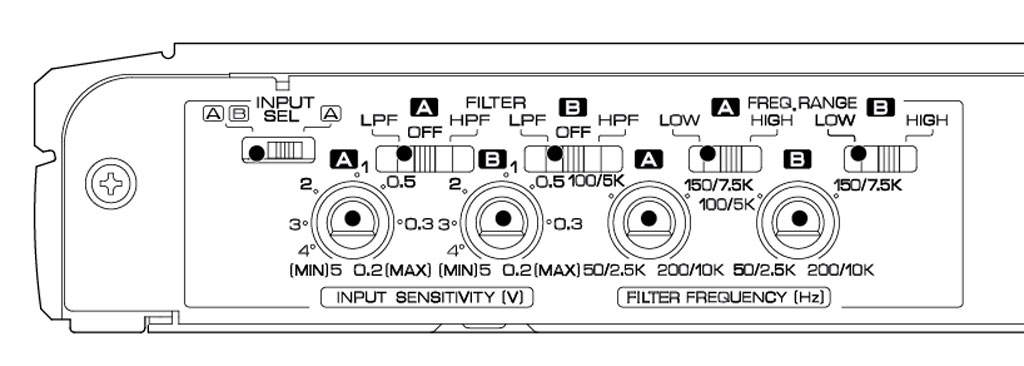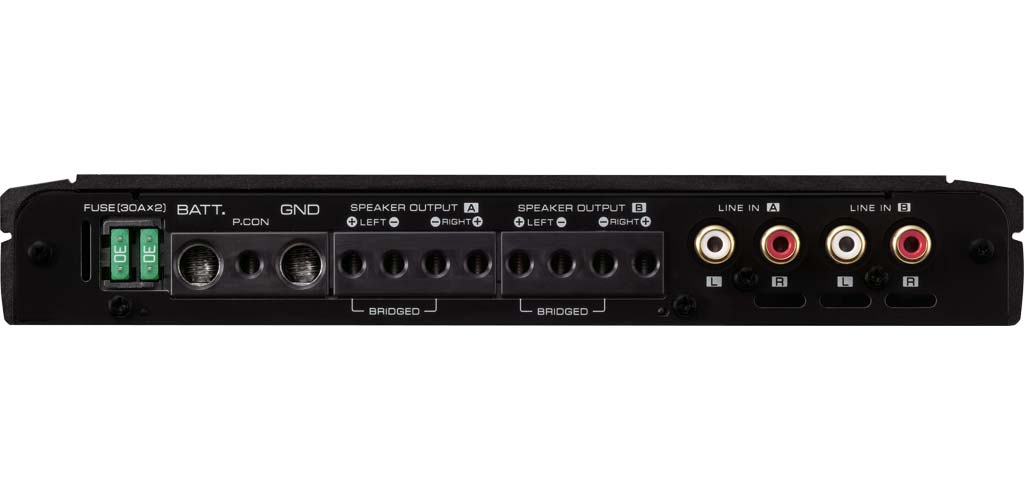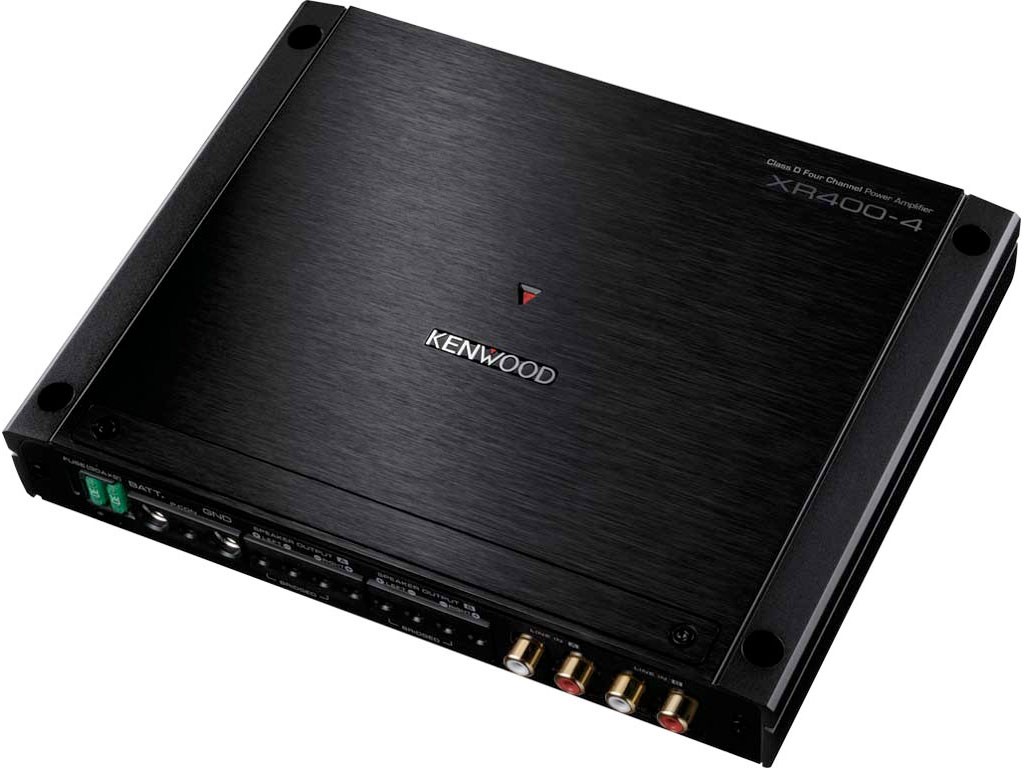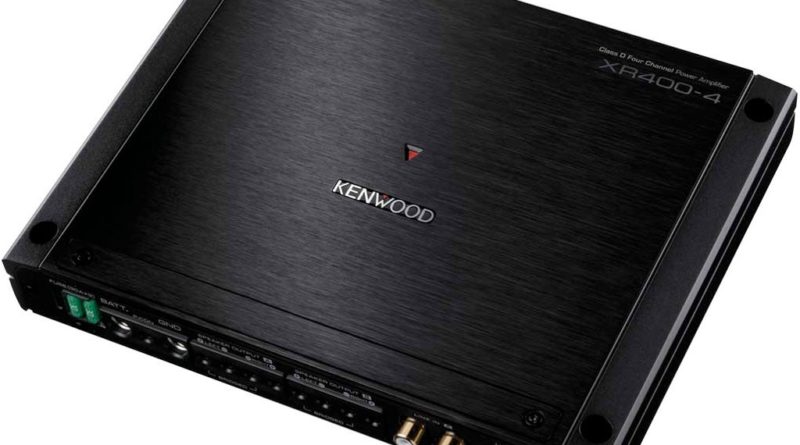Kenwood XR400-4 Four Channel Amplifier
Product Details
Manufacturer: Kenwood
Website: link
Typical Selling price: £229.99 on line
WHAT IT IS
Four channel amplifier of Class D design, made to be extremely thin and to have a very high power density as this amp can make a solid 75W RMS from each channel, so realistically can be three hundred watts of front speaker power for a good set of components. It is made with great solidity and is powered up by four gauge wire to big terminals. Two thirty-ampere fuses prove the current consumption matches claims of output, while sophisticated crossovers offer lots of options. You get all the wire connections on one end power, speaker and RCA signal and the four knobs and five switches for the crossover on the other drop. These can be set to be fed from just one set of inputs or both and the crossovers are controlled by two knobs and four switches as well as the two gain input controls being right there. Allen headed bolts secure the panel that covers the access to the wiring connections which in turn use another two sizes of Allen Key to tighten.
Kenwood XR400-4 crossover section
 In A Nutshell
In A Nutshell
A very good amplifier from a very famous brand, with actual legendary amplifiers in their past. (Iceman swore by his ‘˜secret’ Kenwood 1023’s way back when and WILL be peeved at me for telling you, even though most of you were five at the time.) The Kenwood XR-400-4 is compact and powerful, with really good connections and great gobs of clean power. It cares naught about low voltages and will play until your battery ‘˜sodas’ terminally! The sound is good enough to make you respond to the music, rather than listen to the equipment and that is pretty much all that matters.
The SCORES
Overall 8.6
Sound Quality 8
Power Output 9
Features 9
Build Quality 9
Value For Money 8
Happily recommended by Talk Audio

Editor Review : Kenwood XR400-4 Four Channel Amplifier
Being a high quality amplifier or claiming to be – meant that I was going to have to test the amplifier with a set of really good speakers, or ones I suspected of being really good. To which end, I hooked up a set of Morel Virtus 602 components. They make them up to nearly two grand a set and also down to an affordable end, called Maximo but Virtus are midmarket at £600 as sold and aught to be awfully revealing.
As a classic set of components, they came with a passive crossover. Now that means you are supposed to put one speaker wire pair into the box that feeds music to the drivers via the gubbins inside. With THIS amp, you could run active, or one channel per actual speaker. You do need to know what you are doing to do this, as too much deep stuff up a tweeter can kill it. Too much high stuff up a midbass will just not play all that well. So in an effort to try at least part of the crossover system, I hooked the resident Vieta 6x9s with the huge bass output, to the other pair of channels, so I could experiment. The idea was to use the big ovals as subwoofers, denying them any mids and highs, while keeping bass below, say 70Hz or so, from really playing through the components.
Each channel has a crossover that can be set to ‘˜off’ or else used to allow frequencies higher than that point picked, to go by, or ‘˜PASS’, or else to only allow through those tones below the chosen crossover point. You can, at the flick of another switch on each crossover, choose to use high or low range. This varies the crossovers’ range from 50Hz to 200Hz up to 2.5kHz to 10kHz. Thus subs lowpass or else a tweeter crossover range. I used low range lowpass to cross from 100Hz and down for the ovals and then low range high pass to play the Virtus 602 set.
I had issues with the power supply as well as rusty recall of a particularly gnarly electrikakal path through a bunch of fat wires and StreetWires mega-items of power accessory-ness. Yes, it was confusing but I tend to over-use fusible links and places I can disconnect the DC, as well as carefully connect up. I have only once or twice flung BIG sparks about the landing.
But I got it all fired up and was immediately impressed. Yes, I was using hippy music but one of the most layered, deep and fabulously recorded and produced albums of all time. Now legendary, I had posters on my wall at UEA of Dark Side Of The Moon. I was on holiday when I heard it in a damn Spanish roadside bar. He had a massive pair of Technics speakers and clearly had a classy bit of hench to drive it, behind the bar. The speakers were angled and hung and I was transfixed as all the ticking clocks burst into chime and tear your head off. The recording is amazingly uncongested but most systems will make this muddy. You need one FAST rise time in your amplifier, as well as a decent power envelope to run the damn material. Especially from SACD, as this is Spinal Tap CD. It’s One More, and everything sounds louder than everything else. I love it.
I figured the crossovers would be great fun and indeed, were easy to set. First. I turned the big ones down and the Morels up. And had an adjust and a tickle. Then, lowered their gain and raised the ovals’ output back up and took out the tops. Finally, lifted it all back up again
And while the crossovers really work, both my test rig sets of speakers were just too good! The damn Vietas have a tiny bullet compression tweeter, never seen before or since, and the Morels’ midbass drivers are bloody incredible. Thus, I messed about some more and in the event decided that the slopes of the crossovers were a bit soft for hardcore audiophillic purposes but rather easier to set for installation issues. They are good for that, yet in the event, I switched them both to ‘˜off’ and simply used the gains to balance the output.
And my world was filled with Floyd.
The Kenwood XR-400-4 amplifier is such a small spudney and yet wow does it put OUT! And considering that the power supply was so poor that the headunit had a mental breakdown and I found the effective playback current limit on my old battery with ten Amp marine charger trying its best! It cuut OUT!
I turned it down a tad but I can tell you that the power claims seem to be true. It really woke the speakers up and I was worried about the neighbours yet again. Starting the track with all the tinkly bits in again, showed off that the small sized thing has a good ‘˜rise time’. This matters to making tweeters sound sweet. It’s about the individual vibrations of a cello bow, the actual dirty raspberry blown by a soggy sax reed and the tinkle of a bell. That Morel had supplied a deliciously high quality driver with Virtus 602, was all good. For it revealed all the amp can do.
The fatty bum ovals were doing their part as their ceramic coated metal cones were dropping richness way below what the sixes could manage, all fuelled ably by two channels on Skinny Britches, the XR-400-4.
Yes, for three hundred quid, you are not getting stupendous power, nor will it be absurdly esoteric in noise floor and purity, as that stuff costs big money. But what has been achieved for the price is impressive. For one, this genuinely is a possible under seat install, which will help sell amps to them’s as won’t touch a boot. Fort another, despite its tiny foot print and less than many book’s thickness, it is a ‘˜proper’ amp. Though fully featured, I would not recommend the use with a single set of components, active. Rather, if you have compos of big audio ability, then run this, dual bridged instead and it’ll do big two hundred watt stereo. And that’s meaty for three hundred quid.
I like this, just sorry it took so long to get around to.
Where all the wires go.
 Full Specifications
Full Specifications
– Class D Amplifier
– Full Range Digital Amplifier
– Load Capability: 2Ω Stable
– Maximum power output (4Ω): 250W x 4
– Rated power output (4Ω, 14,4V): 75W x 4 (20Hz to 20000Hz, 1%THD)
– Rated power output (2Ω, 14,4V): 100W x 4 (1000Hz, 1%THD)
– Rated power output Bridged (4Ω, 14,4V): 200W x 2 (1000Hz, 1%THD)
– Rated power output (CEA-2006 Compliant): 75Watts RMS x 4 at 4 ohms and 1% THD
– Low-pass Filter 50 to 200Hz & 2.5 to 10kHz (-12dB/oct)
– High-pass Filter: 50 to 200Hz & 2.5 to 10kHz (-12dB/oct)
– Dual Mono Drive Capability
– Switched Mode Power supply, with Power MOS-FET
– Power Indicator
– Protection function
– Line in: 2 RCA (Gold Plated) A/B
– Input Selector: A/AB
– Single Side Terminals
– Full Contact Terminal
– Gold Plated Power & Speaker Terminals
– Chassis: Aluminium Die-cast
– Input Sensitivity: 0.2 to 5V
– Input Impedance 10kΩ
– Signal to Noise Ratio: 100dB
– Signal to noise ratio (CEA-2006): 76dBa (Reference: 1 Watt into 4 Ohms)
– Frequency response (+0dB, -3dB) 20Hz to 20000Hz
– Operating voltage: 14.4V (11V to 16V allowable)
– Maximum current consumption: 37A
– Dimensions (WxHxD): 220 x 35 x 169(mm)
– Weight: 1.5kg
Svelte and powerful.


